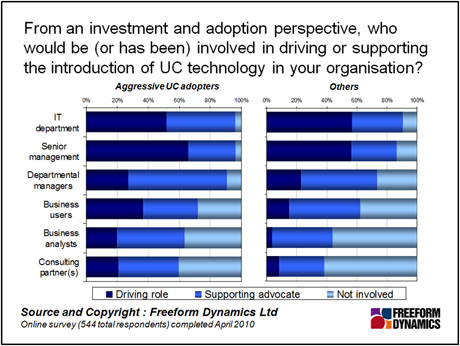Once companies have overcome the hurdle of defining what unified communications (UC) is and does, probably the biggest hindrance they face in implementing this technology is return on investment (ROI).
The quest for a UC implementation will often start with the IT department. These are the people who know how to deal with the day-to-day ICT issues such as a TDM switch reaching its end of life or relocating to a new site. They also understand the technologies that are increasingly mainstream, such as IP telephony and UC, and the value they hold for the business.
Conveying needs back into the business can be tricky, however. For example, explaining to a CFO that a UC installation is needed when he sees only a perfectly adequate set of systems in place is no easy task.
Convincing execs to back a UC implementation lies with ROI – is the company going to get back what it puts in, and more? And how much and in what timeframe?
A temptation of businesses is to break needs and wants into discrete chunks, reviewed in isolation. This in itself is a painstaking process, and can result in difficult to resolve juxtapositions.
Consider the case for instant messaging (IM), for example. Within an organisation, proponents of IM may identify a whole raft of benefits, and argue that it would improve their business productivity. They may also be able to identify the extent to which their productivity improves – gaining five minutes per day extra time, for example. On the flip side, however, there may be another group that sees IM as a waste of time.
Justifying an implementation then becomes a juggling act, which may be made more difficult depending on the relative seniority of the groups involved. The same exercise could be carried out with videoconferencing, web conferencing, mobile SMS and so on, and result in similar outcomes – but no overall conclusion about the organisation’s ITC strategy.
A better approach is to hold ’discovery sessions’ which bring together a broad group of stakeholders to discuss business problems and how they can be addressed, i.e. with what technology.
By then, looking at what returns a technology will deliver, and where it might add value, the company will be able to identify the ROI needed. Repeating this process across a number of different sessions will enable the business to gradually build up an overall picture of its business needs and technology usage.
As well as ending up with a business case that will hold sway with budget holders, it delivers two other important benefits.
The first of these is bringing together stakeholders to discuss business issues from different angles. This in turn ensures that both the issues and solutions are thoroughly understood by key parties in the company.
For UC, Freeform Dynamics research shows companies which involve a broader group of stakeholders are likely to implement UC more aggressively, and more successfully.
The diagram below, based on recent interviews with IT and business managers and practitioners, shows the correlation between wider and deeper involvement of stakeholders, and a broader UC implementation.

The second key benefit of this approach is, because the process is systematic, it will highlight any lurking business problems. Moreover, it will allow for the exploration of new opportunities that would not otherwise have been considered. For example, a videoconferencing solution delivers the obvious benefit of reducing staff travel costs, but it may also open new avenues of opportunity, by providing access to new suppliers and partners that were previously off the radar because of geographic location.
A company may decide to ’go it alone’, and embark on a UC project without external help from a consultant or vendor. While this may make the business feel more empowered, we don’t recommend it.
Given the complexity of the process, and the likelihood of internal politics rearing its head, an external party can facilitate change and act as a mediator. Additionally, they will bring the added benefit of experience, and will be able to identify potential issues, pitfalls and solutions that the business would otherwise overlook.
Irrespective of whether external help is sought, starting with a discussion of the business problems rather than the technology solution will help a company put UC into proper perspective, and determine whether and where it fits into its plans and objectives.
Content Contributors: Josie Sephton
Through our research and insights, we help bridge the gap between technology buyers and sellers.





Have You Read This?
From Barcode Scanning to Smart Data Capture
Beyond the Barcode: Smart Data Capture
The Evolving Role of Converged Infrastructure in Modern IT
Evaluating the Potential of Hyper-Converged Storage
Kubernetes as an enterprise multi-cloud enabler
A CX perspective on the Contact Centre
Automation of SAP Master Data Management
Tackling the software skills crunch